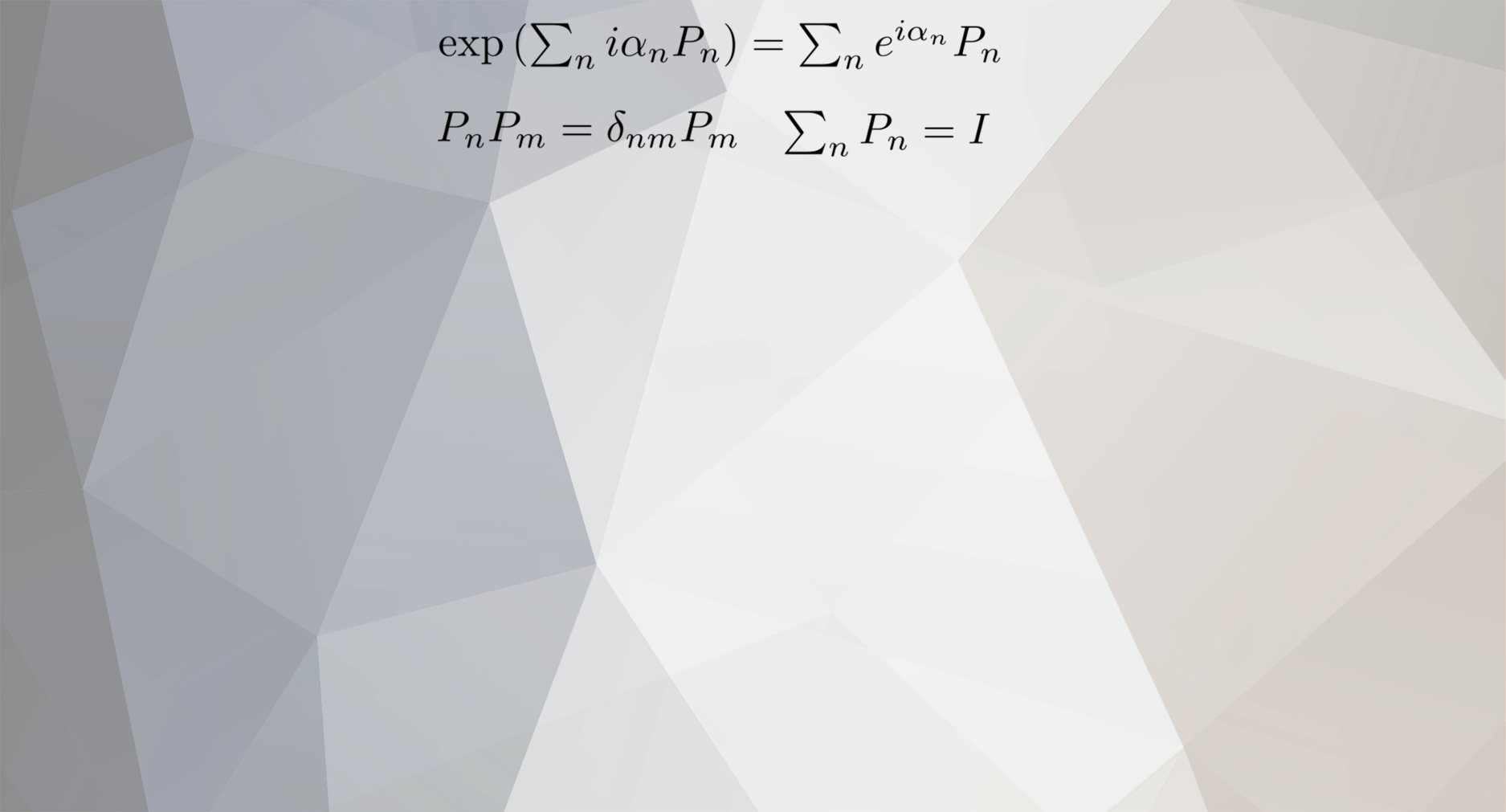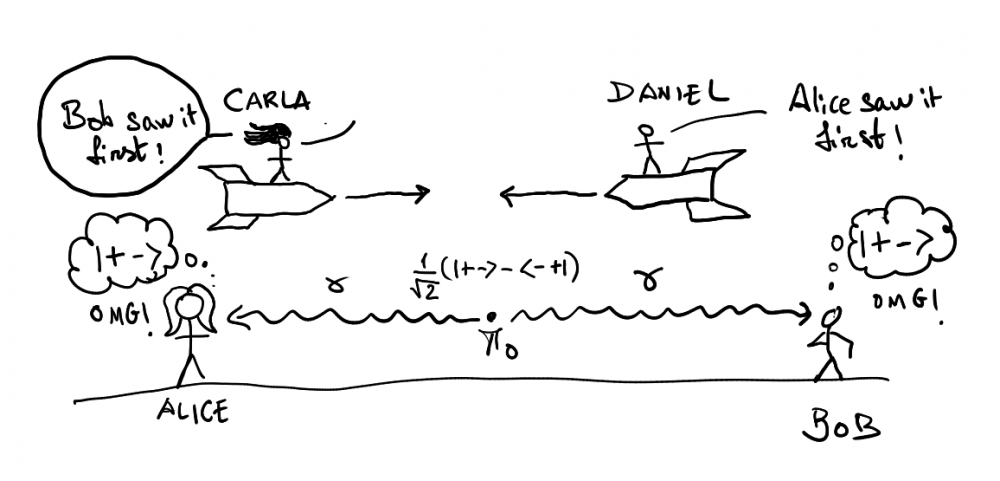-
Posts
4400 -
Joined
-
Days Won
49
Content Type
Profiles
Forums
Events
Everything posted by joigus
-
No!!! Is there any single statement about this that you can get right? Alice and Bob are sitting in the same reference frame. They can use laser to determine they saw it at the same time. They determine they saw it at the same time!!! (In their common inertial reference frame.) Carla and Daniel, on the other hand, equipped with lasers too, are sitting each one on yet two more inertial reference systems. They infer different coordinates for the reception. From the POV of Carla, Bob's photon reaches Bob before Alice's photon reaches Alice; from the POV of Daniel, Alice's photon reaches Alice before Bob's photon reaches Bob. Why do I think you don't understand? Because you don't. You simply don't understand it. You don't. You don't. You don't. You don't. You don't. You don't. You don't. You don't. You don't. You don't. You don't. You don't. You don't. You don't. You don't. You don't. You don't. You don't. You don't. You don't. Don't. Don't. Don't. Don't. Don't. Don't. Don't. Don't. Don't. Please do. Please do. Do. Do. Do. Do. Do. Do. Do. Do. Do. Do. Do. Do. Do. Do. Do. Do. Oh, please, do.
-
Nope! I think these comments get to the heart of the matter from a philosophical POV. My take on it is the wave function represents infinitely many occurrences we simply cannot tell apart from each other. IMO, up to a certain point, to the extent that the theory has been mathematically understood, choices may open up. Don't forget that, even when quantum mechanics has given you a valid choice for your \( \left|\psi\right\rangle \), there are infinitely many prescriptions equivalent to each other. Once we've written the state vector in the so-called position representation, \[ \left\langle \left.x\right|\psi\right\rangle =\psi\left(x\right) \] we can still change the prescription point-wise as long as there is a gauge field accompanying it, \[ \psi\left(x\right)\rightarrow e^{iq\theta\left(x\right)}\psi\left(x\right) \] \[ A^{\mu}\left(x\right)\rightarrow A^{\mu}\left(x\right)-\partial^{\mu}\theta\left(x\right) \] So right there gauge ambiguity is telling you your state object is very, very far away from being determined. If I had to bet, I'd say the "mysterious part" --the persistent thwarting of any attempts on our part to determine the system-- is hidden under the carpet of gauge ambiguity: From: https://en.wikipedia.org/wiki/Introduction_to_gauge_theory#Gauge_invariance:_the_results_of_the_experiments_are_independent_of_the_choice_of_the_gauge_for_the_potentials The spin factor of the state being even more deeply non-realist than the space-time part. IOW: Spin variables cannot even be represented by commuting variables.
-
In early Christianity the sharing of the food was the real deal, more similar to what you tell me about the Presbyterian church. From the point of view of healthy practices, holy water at the entrance of Catholic churches must bee teeming with bacteria. So ... eew. I don't think it's very sanitary. Anyway, trying to answer to the question of where it comes from, I've found this, From: https://www.stmarybasilicaarchives.org/archives-desk/history-and-usage-of-holy-water/ But given the role that water played in ancient Judaism, I think we shouldn't completely rule out the possibility that the origins of the practice go as far back as the Essenes, or perhaps earlier.
-
Instant in one reference frame is 1 to 2 in another, and 2 to 1 in yet another for space-like intervals. The order of events is frame-dependent. Please, oh please, do learn some special relativity. At least the basics. "Instant doesn't mean anything in special relativity. That's the point. (Ahem, ahem, sigh.)
-
As a person raised in the Catholic tradition, water was never very high on my agenda. The Church offers you as many servings of it as you want when you enter or leave their offices. What always kept me wondering was why wine was a privilege for the Father only, who did the consecration of bread and wine into the body and blood of Christ. You could have the (sorry excuse for) bread they give away, but never the wine. I've been blood-thirsty ever since. Red wine is a miracle.
-

Best resources for self-studying math from K-12?
joigus replied to Zephyr1779's topic in Mathematics
Yes, but I should have read the post more carefully. I just hope new comments draw attention so that OP can get a proper answer. My idea of American education is that knowledge is more practical than in Spain. I've seen courses in Britain which, even on the theoretical side, go more from example to theoretical idea. I'm more familiar with Britain than America. We have six primary-education courses, then four secondary education courses, and then two pre-universitary courses we call "Bachillerato." I always say any person who would assimilate all the the Bachillerato courses (Science, Human Sciences, Social, and Arts) would --potentially-- be a modern Leonardo Da Vinci +. The unfortunate result is that most people don't get a proper education in any of them, probably due to excessive emphasis on theory, to the detriment of practical knowledge.) -

Hypothesis about the formation of particles from fields
joigus replied to computer's topic in Speculations
It was you who started talking about neutrinos. From a classical POV, neutrinos would have zero magnetic moment. Magnetic moment doesn't come from mass, but from circulating currents. In the context of the Standard Model, they're expected to have a very small magnetic moment, no doubt due to radiative corrections. AFAIK, only upper bounds to magnetic moment of neutrinos have been experimentally determined. It would be a good idea to read what I posted above. -

Best resources for self-studying math from K-12?
joigus replied to Zephyr1779's topic in Mathematics
Thanks. Usually, I don't allow myself more than 5 min of stupidity a day. -

Best resources for self-studying math from K-12?
joigus replied to Zephyr1779's topic in Mathematics
Sorry. What is K-12? -
If you want to go from A to B, it's only natural that the answer will depend on where's A, and where's B. Are you already fluent in algebra, geometry, and analysis? (where's A?) Do you intend to tackle very sophisticated and recent mathematics, like ,eg, Grothendieck's Motives? (where's B?) If you already have a reasonable A, are not too ambitious about B, and also perhaps are relatively young, I see no reason why you wouldn't get there with the sources you propose by following your nose, and intuitively finding where the boundary between what you ignore and you already know actually is. I hope that was helpful.
-

Hypothesis about the formation of particles from fields
joigus replied to computer's topic in Speculations
By the way, @computer. Your idea is a noble one, and I want to pay respect to it. It's such a pity it doesn't work, at least not directly, because... Well, because you need quantum mechanics at some point. To prove to you how intelligent an idea it is, I'll let Einstein do the talking. (My boldface emphasis.) From: Autobiographical and Scientific Reflections; A. Einstein https://ebin.pub/einstein-on-einstein-autobiographical-and-scientific-reflections-0691183600-9780691183602.html I read this little book about 41 years ago. Many of the comments went over my head those many years ago. But that observation, and a couple of other ones, deeply impressed me, and have always stuck with me. -

Hypothesis about the formation of particles from fields
joigus replied to computer's topic in Speculations
My intuition is that it would have to do with a kinematic (Doppler-like) effect, rather than a dynamical one (energy-momentum.) From: https://en.wikipedia.org/wiki/Relativistic_quantum_chemistry#:~:text=Gold appears yellow because it,compared with the incident light. (My emphasis in boldface.) Clarification: By Doppler-like I don't mean that reflected light gets Doppler shifted, but that it's kinematic (like Doppler effect), in this case because orbitals appear compressed, which affects the absorption properties. I hate being vague, but I hope it makes sense and is intelligible. -
Nice account of how it is not spooky, it is not an action, and it is not at a distance. And the reason for the quotation marks in the title: You have to actually read it to see that, of course: IOW => NOT(LOCALITY AND REALISM) => NOT (LOCALITY) OR NOT (REALISM) Quantum mechanics has no underlying realism. Are we there yet? Let me guess: No. Silly me for believing you were in a superposition of yes and no. Funny. I did say exactly that. Only, I dropped the "as if." And was I right, oh man, that it would fly over your head.
-
Lesson number 1 in quantum mechanics: The quantum properties of B are not fixed. They're sure to produce the previous result if you happen to measure the same projection of spin. If you measure another projection of spin, they're completely random (equally likely to give + or -) and, in this case totally uncorrelated with the other particle's values. I told you, "random" doesn't mean much in itself. Give me a probability distribution. Have you ever heard of Bertrand's circle paradox? I propose the game of spotting your most embarrassing mistakes in each of your entries. It would be a fun game. There's no other interest in this thread now.
-
Today I learned gold is not silvery-shining and reflected light from gold gets more reddish because relativistic effects contract the interior shells. Thanks to @exchemist
-
Fearful symmetry. https://en.wikipedia.org/wiki/Ural_owl
-
In what frame are they simultaneous? For spacelike separated events, simultaneity relations depend on the observer, as you should know. And now I understand that's what @MigL was trying to say. IOW simultaneity is frame-dependent. No. Alice and Bob are not imaginary. They are detectors. Don't dodge the question.
-
I'm assuming you mean Alice and Bob are at different points in the same inertial frame? @Eise introduced a reference to a paper in which the detectors are moving, which would correspond to what you're saying literally. The conclusion seems to be that the projection postulate is weakened by the results. Let me go back to Alice and Bob being distant, but in the same state of motion. Both Alice and Bob tell nothing to each other about what polarisation direction they're going to measure (that way we guarantee that nothing physical is getting through.) If either Bob or Alice told the other one what they're gonna do, and they can trust each other, that's another matter. You can even bring to the problem whether Alice trusts Bob --or viceversa. That's nothing to do with the physics of it. And I'll be "brutally" clear: Can a woman ever trust a man? --if you will. Alice measures Sx (x-projection of spin.) It produces +. Question: What can she tell from that? Answer (think about it, @bangstrom😞 Nothing: Zilch, nothing at all, überhaupt nichts, nada, nada, pues nada. What has Bob measured? I don't know. In fact, I don't trust him. What has Bob obtained as a result of his measurement? I haven't the faintest idea. In a nutshell: Alice needs infinitely many experiments to --at least-- know Bob has (even!!!) performed a measurement. In fact --I can argue this-- she cant can only tell --after an eternity-- precisely what component of spin Bob has measured. I'm not sure I'm answering your question, @MigL. (My emphasis.) Truly ignorance is bold and knowledge is reserved --Thucydides. That's all I have to say to your suggesting I'm a novice and you're the "expert" explaining to me how this all works. I told you I don't know many details of TIQM --I'm not particularly interested in it--, but building up some makeshift acquaintance with it in order to rebut your WAG assumptions is certainly not much of a challenge. Here: From: https://en.wikipedia.org/wiki/Transactional_interpretation The wave function: W-A-V-E F-U-N-C-T-I-O-N. AFAIK, TIQM is for electrons, protons, neutrons... Any particle that, for some regime, satisfies the Schrödinger equation. It is not a theory of light. It basically purports to be a theory of electrons and the like. I don't think anybody has tried to apply it to anything other than semi-qualitative discussions of quantum paradoxes. Photons are dealt with, not with quantum mechanics, but with quantum field theory. The WF theory, OTOH, is a theory of half-advanced, half-retarded classical EM fields, the electrons being classical relativistic particles. It is, therefore, a field theory of light. I forget whether it allows you to give any meaning to radiation reaction and electron self-energy. I think you put it by hand. Am I right? You tell me, you're the expert!! 🤣 QFT is a theory reminiscent of the WF theory in that you have the amplitudes half-advanced, half-retarded, but for all fields: matter fields, and radiation fields. In every one of these theories, you need to impose boundary conditions to the waves, so the resulting wave is relativistic-causality-compliant and, of course, propagates locally. In none of these theories could you have, eg, a spherically symmetric solution purely sourcing into (instead of out of) a point. Can you do that with any of them without violating the boundary conditions? Here, boundary conditions all over it, FYI: Again from: https://en.wikipedia.org/wiki/Transactional_interpretation And all known conservation laws are local --continuity equation. If they're talking about conservation of momentum, energy, and angular momentum and probability density, then it's local to the bone. You're very likely disgracing a theory that's probably much more serious than you make it look. Now, I can see very easily where you get confused. It's easy if you're clueless about the maths and just follow the words. More from https://en.wikipedia.org/wiki/Transactional_interpretation: (My emphasis.) Wow! So it is non-local. Or is it? @bangstrom wants it badly, for some reason, but no. Hold your horses Mr. "expert." What do you find when you click on the magic words "non-local"? (Wikipedia again) This: Which, as discussed ad nauseam, is only because quantum mechanics is essentially, undoubtedly, unmistakably non-realistic. Not because it is non-local in any way. You keep getting starry-eyed by these words "non-local." Do you not understand the implications of the Kochen-Specker theorem? (Rhetorical question.) QM is local. Gell-Mann has told you so. Feynman has told you so. Coleman has told you so. Zeilinger has told you that he prefers "non-realistic" to "non-local" --thanks to @Eise Hossenfelder has told you so. Swansont has told you so. MigL has told you so. Eise has told you so. I have told you so. Take care, Joigus
-
TIQM is not a theory of light. WF theory is. QFT is not. This one (again): You said, It isn't EM, and Cramer calls it a transaction. Oh. What the hell is it? Will you finally stop talking about what it is not or how some people call it, come clean, and tell us what it is?
-
This is based on TIQM, which you have declared yourself not to believe in before. Solutions to any wave theory based on advanced waves establish boundary conditions that guarantee that no signal can be "advanced" when everything is said and done. WF theory: absorber at infinity; QFT: Feynman-Stueckelberg propagator that guarantees fields commute or anti-commute at space-like intervals. I don't know TIQM in detail, but I'm sure it imposes boundary conditions to guarantee relativistic causality. Otherwise it would go directly into the trash can. You're clutching at straws just in order not to answer to an embarrasing question. At what point will you be done with the stubborn denial of an experimental fact?
-
Wrong. Wrong. Obscure at the very least. Not very meaningful. Totally meaningless. Could you, at least, answer Swansont's question, please?
-
So you're proposing they do, what, 100000? sequential measurements, to check that particle after particle that were, what, 500 miles away of each other?... are "decohering" with each other(!!!???) so there is no interference pattern? What are you measuring that decoherence against? After many hours have passed you conclude every time something instantaneous must have happened every single time? Decoherence can be checked for components of the wave function that hit on pretty mutually close spots of a screen. It's a property of collectivities of particles, not of pairs of particles. How do you check 500-mile-away wave functions must have decohered? How do you prove interfering patterns are lost between things that are, by now, 500 miles away? You clearly don't understand what decoherence is about. Particles don't decohere with each other. That makes no sense. The quantum state decoheres with itself, like in the double-slit experiment. The statistics of many experiments tell you that.
-
Exactly. Zeilinger is pointing to a widespread confusion. Zeilinger's choice of words is "eerie." Clear symptom that he's not enamoured of the idea. I must say that, even today, some physicists dare not speak out about this, or very openly at all, and choose to sprinkle their language with words like "somehow," "seems like," "said to be," etc.
-
No. Your statement is logically fallacious: https://en.wikipedia.org/wiki/Begging_the_question Sorry, I thought you knew what "begging the question" means. It means you're asking to concede precisely the point that is under scrutiny. Example: Freedom of the press is one of the most important hallmarks of a modern, open society because modern, open societies value the ability of the press to report what’s happening. I hope it's clear why your misunderstanding of "begging the question" makes this discussion very difficult. If you're allowed to stick to one word, and you claim the right to repeat its use by decoupling it into different wordings of it, loosely synonymous, then it's never gonna end. Once your premises are stripped to their bare minimum, you will be going like this: I meant by non-locality what I meant by non-locality. Why? Quantum non-locality. That's the one I mean. And by "interaction" I mean what I mean by "interaction." Not a satisfactory logical posture, is it?
-
Here's the sloppiness and ambiguous language again. The observation is not random, it's a choice. The outcome is random. Now, "random" doesn't mean anything much. What kind of "random"? What probability distribution?: The average is zero. =0 The dispersion is maximal. = 1/2 (equally likely to get +1/2 or -1/2.) OK? This is called begging the question. I could let you off with a warning but, hey. No. Start again, please.


